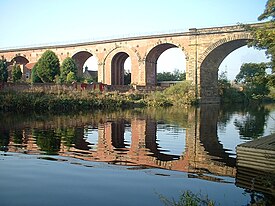Yarm
| Yarm | |
|---|---|
 Yarm Viaduct over the River Tees |
|
| Yarm shown within North Yorkshire | |
| Population | 8,384 (2011 census) |
| OS grid reference | NZ416124 |
| Civil parish |
|
| Unitary authority |
|
| Ceremonial county | |
| Region | |
| Country | England |
| Sovereign state | United Kingdom |
| Post town | YARM |
| Postcode district | TS15 |
| Dialling code | 01642 |
| Police | Cleveland |
| Fire | Cleveland |
| Ambulance | North East |
| EU Parliament | North East England |
| UK Parliament |
|
| Website | www.YarmTC.org |
Yarm is a small town in North Yorkshire, England. The town is on the south bank of the River Tees and is historically part of the North Riding of Yorkshire. The bridge at Yarm marked the furthest reach of tidal flow up the River Tees until the opening, in 1995, of the Tees Barrage, which now regulates river flow above . As the last bridge on the river before the sea, it was superseded by a new toll bridge opened in Stockton in 1771. The oldest part of the town, around the High Street, is situated in a loop of the river, and the newer parts of the town extend to the point where the River Leven meets the River Tees.
The name of the town is thought to be derived from the Old Norse word yarum – meaning an enclosure to catch fish, or from the Old English gearum with the same meaning. Yarm was first mentioned in the Domesday Book of 1086, and was originally a chapelry in the Kirklevington parish in the North Riding of Yorkshire; it later became a parish in its own right.
Dominican Friars settled in Yarm about 1286, and maintained a Friarage and a Hospital in the town, until 1583. Their memory is preserved in the names of Friarage and Spital Bank.
Bishop Skirlaw of Durham built a stone bridge, which still stands, across the Tees in 1400. An iron replacement was built in 1805, but it fell down in 1806. For many years, Yarm was at the tidal limit and head of navigation on the River Tees.
On 12 February 1821, at the George & Dragon Inn, the meeting was held that pressed for the third and successful attempt for a Bill to give permission to build the , the world's first public railway.
In 1890, Bulmer & Co listed twelve inns in Yarm: Black Bull, Cross Keys, Crown Inn, Fleece, George and Dragon, Green Tree, Ketton Ox, Lord Nelson, Red Lion, Three Tuns, Tom Brown, and Union. Also listed was Cross Keys beside the Leven Bridge.
...
Wikipedia

